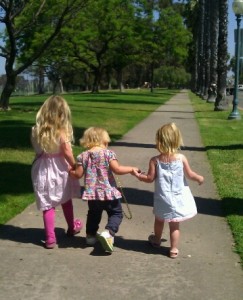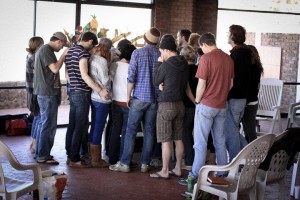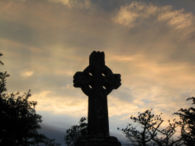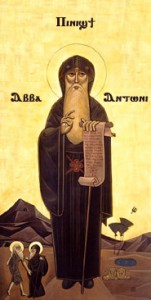Through all of the difficulties of adjusting to living in a new culture, the greatest was the confusion I faced as a white American evangelical. As Huckins states in his article, “Rather than immersing myself in the living narratives, I had been content with a theology and narrative that had been formed for me.”
As my life intersected the numerous narratives being told by the diversity of people living in Israel, I understood that I needed to seriously reconsider both the eschatology and the ecclesiology I’d been handed.
In North America we have the luxury of being highly selective and particular about whom we participate with in the life of a local faith community. Our freedom has provided us the ability of being able to divide ourselves by all kinds of denominational, theological, liturgical, political, racial and economic differences. We clearly delineate between who is in and who is out, who is one of us and who is one of them. Sunday mornings in North America more closely resemble tribal gatherings—each group closely gathered and facing inward—than diverse and interconnected expressions of the body of Christ.
As an American Christian living in Israel, all the ways I had been trained by our culture and my theological education to differentiate myself from other Christians no longer mattered. Participating in a community with other followers of Jesus meant more to me than it ever had before. The small church I experienced was diverse, strange and filled with beautiful tension. American evangelicals, Pentecostals, Messianic Jews, Christian Zionists, Palestinian Christians and followers of Jesus from various other countries and political persuasions all called this community home. Though there was plenty of bickering and arguing, I never witnessed it leading to actual division, neglect or hate. The truth is, we all needed each other to survive the daily struggle of life in Israel. As a legitimate follower of Jesus in the Middle East, you either accept the body of Christ for what it is—a diverse community that transcends race, theology and politics—or you choose to live in isolation.
The problem with the Western understanding of what it means to be a part of the church is that it really only helps our students understand what it means to be a part of a church. Living in Israel transformed my understanding of what it means to be part of the church because I realized that in the United States we have constructed our religious institutions in such a way that we don’t really need each other.
As much as we all needed each other in the community I was part of in Jerusalem, this community also needed connection, support and encouragement from followers of Jesus around the world and in the United States. And, though I never realized it, followers of Jesus in the United States needed connection, support and encouragement from this small and unique community in Jerusalem and from other Christians around the world. We have failed to remember the words of Jesus—that our brothers and sisters are anyone who does the will of God,[1] not just people who look and think like us. This includes Huckins’ friend Mildad, the Palestinian Christian who lives in Bethany.
The kind of ecclesiological isolationism that many Western Christians practice leaves room for our other theological understandings to get distorted. We have allowed ourselves to get in trouble by practicing a weak ecclesiology, especially given the popularity and sensationalism of end-times prophecy and eschatological beliefs that include violence and despair. Our communities haven’t modeled what it means to hold ecclesiology and eschatology (regardless of our specific set of beliefs) in tension and have therefore indirectly taught our students that eschatology trumps ecclesiology.
As Huckins reminds us, according to a dispensational understanding of the eschaton, the existence of the nation of Israel is a necessary part of the sequence of events leading to the return of Christ. Therefore, many evangelical Christians support the nation of Israel in their cause against the Palestinians. As Huckins points out, what many of us don’t know (or don’t care about) is that American Christians are financially and politically supporting the oppression of not only the Palestinian people but other followers of Jesus—Palestinian Christians.
What dispensational theology states in practice is that it is more important to prop up the nation of Israel as a pawn in our end-times game than to stand with, suffer with and support other followers of Jesus who are being oppressed. This is not only one of the reasons dispensational theology is practically untenable but also why our students may not have a more comprehensive understanding of what it means to be a part of the body of Christ.
God confronts Cain after a dispute involving religion, jealousy and the murder of his brother.[2] In a rapidly changing world filled with confusion, tension, violence and possibility, all of us in the Western church are confronted by the asking and answering of Cain’s question, “Am I my brother’s keeper?” If we’re to be the kind of Christians who can hold our theological convictions in tension while modeling and practicing an appropriate ecclesiology, we have to answer this question with, “Yes.” And if we say yes to this question, even if it is only in a whisper, we have no choice but to embrace followers of Jesus from around the world as our brothers and sisters and to actively pursue ways mutual connection, support and encouragement can be experienced.
This brave response will undoubtedly lead to the rethinking and reorganizing of our theological, political, racial and economic opinions, which might be exactly what God wants us in the Western church to do. For the sake of our own souls, for the well-being of followers of Jesus around the world, for the sake of our students—both now and in the future—we have to find the courage to take this step.
1) Invite leaders from other Christian traditions to speak at your youth group, or invite your students and leaders to join you at a gathering of followers of Jesus that looks different from your own.
2) Challenge students to scour internet blogs and news sites looking for stories (both positive and negative) about other Christian communities from around the world. Set aside a few minutes in your weekly gatherings for students to share what they’ve found and to collectively pray for your newly discovered brothers and sisters.
3) Don’t avoid difficult theological, political, racial or economic conversations during your gatherings. Inviting students to hold differences with others in tension will go a long way in the future toward them knowing how to exist in connection with followers of Jesus who are different from them.




